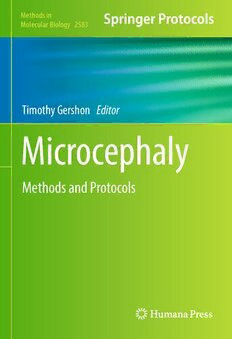
Microcephaly: Methods and Protocols PDF
Preview Microcephaly: Methods and Protocols
Methods in Molecular Biology 2583 Timothy Gershon Editor Microcephaly Methods and Protocols M M B ETHODS IN OLECULAR IO LO GY SeriesEditor JohnM.Walker School of Lifeand MedicalSciences University ofHertfordshire Hatfield, Hertfordshire, UK Forfurther volumes: http://www.springer.com/series/7651 For over 35 years, biological scientists have come to rely on the research protocols and methodologiesinthecriticallyacclaimedMethodsinMolecularBiologyseries.Theserieswas thefirsttointroducethestep-by-stepprotocolsapproachthathasbecomethestandardinall biomedicalprotocolpublishing.Eachprotocolisprovidedinreadily-reproduciblestep-by- step fashion, opening with an introductory overview, a list of the materials and reagents neededtocompletetheexperiment,andfollowedbyadetailedprocedurethatissupported with a helpful notes section offering tips and tricks of the trade as well as troubleshooting advice. These hallmark features were introduced by series editor Dr. John Walker and constitutethekeyingredientineachandeveryvolumeoftheMethodsinMolecularBiology series. Tested and trusted, comprehensive and reliable, all protocols from the series are indexedinPubMed. Microcephaly Methods and Protocols Edited by Timothy Gershon Department of Pediatrics, Children’s Center for Neuroscience Research, Emory University School of Medicine, Atlanta, GA, USA Editor TimothyGershon DepartmentofPediatrics,Children’s CenterforNeuroscienceResearch EmoryUniversitySchoolofMedicine Atlanta,GA,USA ISSN1064-3745 ISSN1940-6029 (electronic) MethodsinMolecularBiology ISBN978-1-0716-2751-8 ISBN978-1-0716-2752-5 (eBook) https://doi.org/10.1007/978-1-0716-2752-5 ©SpringerScience+BusinessMedia,LLC,partofSpringerNature2023 Thisworkissubjecttocopyright.AllrightsarereservedbythePublisher,whetherthewholeorpartofthematerialis concerned,specificallytherightsoftranslation,reprinting,reuseofillustrations,recitation,broadcasting,reproduction onmicrofilmsorinanyotherphysicalway,andtransmissionorinformationstorageandretrieval,electronicadaptation, computersoftware,orbysimilarordissimilarmethodologynowknownorhereafterdeveloped. Theuseofgeneraldescriptivenames,registerednames,trademarks,servicemarks,etc.inthispublicationdoesnotimply, evenintheabsenceofaspecificstatement,thatsuchnamesareexemptfromtherelevantprotectivelawsandregulations andthereforefreeforgeneraluse. Thepublisher,theauthors,andtheeditorsaresafetoassumethattheadviceandinformationinthisbookarebelievedto betrueandaccurateatthedateofpublication.Neitherthepublishernortheauthorsortheeditorsgiveawarranty, expressedorimplied,withrespecttothematerialcontainedhereinorforanyerrorsoromissionsthatmayhavebeen made.Thepublisherremainsneutralwithregardtojurisdictionalclaimsinpublishedmapsandinstitutionalaffiliations. ThisHumanaimprintispublishedbytheregisteredcompanySpringerScience+BusinessMedia,LLC,partofSpringer Nature. Theregisteredcompanyaddressis:1NewYorkPlaza,NewYork,NY10004,U.S.A. Preface Microcephaly, which in children is defined by head circumference two to three standard deviations smaller than the mean expected for age and gender, is a potentially disabling developmental disorder [1]. Microcephaly may be congenital or acquired, and can result from any process that impairs brain growth more than the growth of the rest of the body. Causes of congenital microcephaly include genetic disorders, maternal infections, and intrauterinetoxicexposures[2–5].Postnatalbraininjurymaycauseacquiredmicrocephaly, as seen in hypoxic-ischemic encephalopathy [6–8]. The common link between these pro- cesses is insufficient proliferation of neural stem or progenitor cells, resulting from a combinationofinappropriatecelldeathandprematurelossofproliferativepotential[9]. Research on the pathogenesis of microcephaly addresses a significant human health concern and at the same time provides information on fundamental processes of brain growth [10]. Zika-virus associated microcephaly remains a threat to public health for which new interventions are urgently needed [11, 12]. Genomic medicine has identified a growing number of genetic microcephaly syndromes, and families with identified micro- cephaly mutations need informed counseling and new experimental treatments. Studies of Zika virus, genetic microcephaly, and other microcephaly-causing pathologies, moreover, can reveal mechanisms and factors that are essential for normal brain growth [13, 14]. Insight from microcephaly studies may further inform brain tumor biology, providing anotheropportunityforclinicalrelevance[14,15].Importantbasicandtranslationalinsight canthusbelearnedfromstudiesofmicrocephalypathogenesis. Here,weprovideasetofimagingandmoleculartechniquesforadvancingmicrocephaly research by analyzing neural progenitor proliferation, survival, and gene expression. All of these techniques envision using the mouse as a model system, and comparing mice with microcephaly-inducingconditionstohealthy,age-matchedcontrols.Tocomplementcellu- lar, metabolic, and transcriptomic analyses, we provide methods for analysis of three- dimensional brain growth using MRI and developmentally adapted analysis of mouse behavior in the neonatal period. These methods are intended as a starting point for microcephaly investigations, through which diverse experimental conditions related to microcephalycanbesubjectedtomechanisticanalyses. Atlanta,GA,USA TimothyGershon References 1. AshwalSetal(2009)Practiceparameter:Evaluationofthechildwithmicrocephaly(anevidence-based review):reportoftheQualityStandardsSubcommitteeoftheAmericanAcademyofNeurologyand thePracticeCommitteeoftheChildNeurologySociety.Neurology73:887–897 2. Schuler-Faccini L etal (2022)Neurodevelopment in children exposed toZika in utero: clinical and molecularaspects.FrontGenet13:758715 3. Kempinska W, Korta K, Marchaj M, Paprocka J (2022) Microcephaly in neurometabolic diseases. Children(Basel)9(1):97.https://doi.org/10.3390/children9010097 v vi Preface 4. GulloGetal(2022)CongenitalZikasyndrome:geneticavenuesfordiagnosisandtherapy,possible management and long-term outcomes. J Clin Med 11(5):1351. https://doi.org/10.3390/ jcm11051351 5. ZaqoutS,KaindlAM(2021)Autosomalrecessiveprimarymicrocephaly:notjustasmallbrain.Front CellDevBiol9:784700 6. Preeti S et al (2019) Anthropometric measures as biomarkers of neurodevelopmental outcomes of newborns with moderate to severe hypoxic ischemic encephalopathy. J Neonatal Perinatal Med 12: 127–134 7. Rousset CI, Baburamani AA, Thornton C, Hagberg H (2012) Mitochondria and perinatal brain injury.JMaternFetalNeonatalMed25(Suppl1):35–38 8. MercuriEetal(2000)Headgrowthininfantswithhypoxic-ischemicencephalopathy:correlationwith neonatalmagneticresonanceimaging.Pediatrics106:235–243 9. JamuarSS, WalshCA (2015)Genomicvariants andvariations in malformationsofcorticaldevelop- ment.PediatrClinNorthAm62:571–585 10. Becerra-Solano LE, Mateos-Sanchez L, Lopez-Munoz E (2021) Microcephaly, an etiopathogenic vision.PediatrNeonatol62:354–360 11. Wilder-SmithAetal(2021)ThelegacyofZikaPLAN:atransnationalresearchconsortiumaddressing Zika. Glob Health Action 2021; 14(Suppl): 2008139. https://doi.org/10.1080/16549716.2021. 2008139 12. SantiagoHC,Pereira-NetoTA,Goncalves-PereiraMH,TerzianACB,DurbinAP(2022)Peculiarities ofZikaimmunityandvaccinedevelopment:lessonsfromdengueandthecontributionfromcontrolled humaninfectionmodel.Pathogens11 13. Komarasamy TV, Adnan NAA, James W, Balasubramaniam V (2022) Zika virus neuropathogenesis: thedifferentbraincells,hostfactorsandmechanismsinvolved.FrontImmunol13:773191 14. LangPY,GershonTR(2018)Anewwaytotreatbraintumors:targetingproteinscodedbymicro- cephalygenes?:braintumorsandmicrocephalyarisefromopposingderangementsregulatingprogeni- torgrowth.Driversofmicrocephalycouldbeattractivebraintumortargets.Bioessays40:e1700243 15. IegianiG,DiCuntoF,PallaviciniG(2021)Inhibitingmicrocephalygenesasalternativetomicrotu- buletargetingagentstotreatbraintumors.CellDeathDis12:956 Contents Preface ..................................................................... v Contributors................................................................. ix PART I CELLULAR ANALYSES OF NEURAL PROGENITORS 1 DissociationofCerebellarGranuleNeuronProgenitorsforCulture, FACS,Transcriptomics,andMolecularBiology...... ........ ....... ........ 3 JenniferKarinOcasio 2 MaintainingCerebellarGranuleNeuronProgenitorsinCellCulture.......... 9 JenniferKarinOcasio 3 ProliferationAnalysisofCerebellarGranuleNeuronProgenitors forMicrocephalyResearch,UsingImmunofluorescentStaining andFlowCytometry ....... ........ ....... ....... ........ ....... ........ 13 JenniferKarinOcasio 4 ConventionalandSpectralKaryotypingofMurineCerebellar GranuleNeuronProgenitors........ ....... ..... .. ...... .. ...... ......... 25 GouriNanjangud PART II ANALYSES OF NEURAL PROGENITORS IN SITU 5 ProcessingNeonatalMouseBrainsforImmunohistochemicalAnalysis: AsRequiredforIncludingSpindleOrientationAnalysisandAnalysis ofDNADamageandApoptosis ..... ....... ....... ........ ....... ........ 49 GabrielaDelaCruz,NanaNikolaishvili-Feinberg, ScottE.Williams,andTimothyR.Gershon 6 AutomatedImmunofluorescenceStainingforAnalysisofDNADamage andApoptosisinBrainSections...... ....... ....... ........ ....... ........ 55 GabrielaDelaCruz,NanaNikolaishvili-Feinberg, andTimothyR.Gershon 7 AutomatedImmunofluorescenceStainingforAnalysisofMitoticStages andDivisionOrientationinBrainSections.......... ... ..... ....... ........ 63 GabrielaDelaCruz,NanaNikolaishviliFeinberg, andScottE.Williams PART III RNA-SEQ ANALYSIS WITH SINGLE-CELL RESOLUTION (SCRNA-SEQ) 8 scRNA-seqforMicrocephalyResearch[I]:Single-CellDroplet Encapsulation,mRNACapture,andcDNASynthesis ........ ....... ........ 83 BenjaminBabcockandSethWeir 9 scRNA-seqforMicrocephalyResearch[II]:PreparationofSingle-Cell cDNALibraries..... ....... ........ ....... ....... ........ ....... ........ 99 BenjaminBabcockandSethWeir vii viii Contents 10 scRNA-seqforMicrocephalyResearch[III]:ComputationalAnalysis ofscRNA-seqData......... ........ ....... ....... ........ ....... ........ 105 BenjaminBabcockandDanielMalawsky 11 scRNA-seqforMicrocephalyResearch[IV]:DirichletRegression forSingle-CellPopulationDifferences....... ....... ........ ....... ........ 123 DanielMalawskyandTimothyR.Gershon PART IV MRI ANALYSES OF THE MOUSE BRAIN 12 MouseBrainMRI:IncludingInVivo,ExVivo,andfcMRI for theStudyofMicrocephaly....... ....... ....... ..... ... ...... ......... 129 MartinJ.MacKinnon,Tzu-WenW.Wang,andYen-YuI.Shih 13 Whole-BodyMouseFluxomicAnalysistoDetectMetabolic DisruptionsAssociatedwithMicrocephaly:Using13CIsotopes ...... ........ 149 AndreyP.Tikunov PART V BEHAVIORAL PHENOTYPING IN NEONATAL MICE 14 NeonatalBehavioralScreenforMouseModelsofNeurodevelopmental Disorders .......... ....... ........ ....... ....... ........ ....... ........ 159 KathrynM.Harper,ViktoriyaD.Nikolova, MonikaE.Conrad,andSherylS.Moy Index ...................................................................... 175 Contributors BENJAMINBABCOCK • DepartmentofMedicine,DivisionofImmunology,LowanceCenter forHumanImmunology,EmoryUniversitySchoolofMedicine,Atlanta,GA,USA; DepartmentofNeurology,UniversityofNorthCarolinaMedicalSchool,ChapelHill,NC, USA MONIKAE.CONRAD • DepartmentofPsychiatry,TheUniversityofNorthCarolinaatChapel Hill,ChapelHill,NC,USA;CarolinaInstituteforDevelopmentalDisabilities,The UniversityofNorthCarolinaatChapelHill,ChapelHill,NC,USA GABRIELADELACRUZ • DepartmentofPathology&LaboratoryMedicine,TheUniversityof NorthCarolinaatChapelHill,ChapelHill,NC,USA;PathologyServicesCore,The UniversityofNorthCarolinaatChapelHill,ChapelHill,NC,USA;Lineberger ComprehensiveCancerCenter,TheUniversityofNorthCarolinaatChapelHill,Chapel Hill,NC,USA;TranslationalPathologyLaboratory,TheUniversityofNorthCarolinaat ChapelHill,ChapelHill,NC,USA TIMOTHYR.GERSHON • LinebergerComprehensiveCancerCenter,TheUniversityofNorth CarolinaatChapelHill,ChapelHill,NC,USA;DepartmentofNeurology,The UniversityofNorthCarolinaatChapelHill,ChapelHill,NC,USA;UNCNeuroscience Center,TheUniversityofNorthCarolinaatChapelHill,ChapelHill,NC,USA KATHRYNM.HARPER • DepartmentofPsychiatry,TheUniversityofNorthCarolinaat ChapelHill,ChapelHill,NC,USA;CarolinaInstituteforDevelopmentalDisabilities, TheUniversityofNorthCarolinaatChapelHill,ChapelHill,NC,USA MARTINJ.MACKINNON • Center forAnimalMRI,UniversityofNorthCarolinaatChapel Hill,ChapelHill,NC,USA;BiomedicalResearchImagingCenter,UniversityofNorth CarolinaatChapelHill,ChapelHill,NC,USA;JointDepartmentofBiomedical Engineering,UniversityofNorthCarolinaatChapelHill,ChapelHill,NC,USA; DepartmentofNeurology,UniversityofNorthCarolinaatChapelHill,ChapelHill,NC, USA DANIELMALAWSKY • DepartmentofNeurology,UniversityofNorthCarolinaMedicalSchool, ChapelHill,NC,USA;WellcomeSangerInstitute,WellcomeGenomeCampus,Hinxton, UK SHERYLS.MOY • DepartmentofPsychiatry,TheUniversityofNorthCarolinaatChapel Hill,ChapelHill,NC,USA;CarolinaInstituteforDevelopmentalDisabilities,The UniversityofNorthCarolinaatChapelHill,ChapelHill,NC,USA GOURINANJANGUD • MemorialSloan-KetteringCancerCenter,NewYork,NY,USA NANANIKOLAISHVILI-FEINBERG • DepartmentofPathology&LaboratoryMedicine,The UniversityofNorthCarolinaatChapelHill,ChapelHill,NC,USA;Translational PathologyLaboratory,TheUniversityofNorthCarolinaatChapelHill,ChapelHill,NC, USA;PathologyServicesCore,TheUniversityofNorthCarolinaatChapelHill,Chapel Hill,NC,USA VIKTORIYAD.NIKOLOVA • DepartmentofPsychiatry,TheUniversityofNorthCarolinaat ChapelHill,ChapelHill,NC,USA;CarolinaInstituteforDevelopmentalDisabilities, TheUniversityofNorthCarolinaatChapelHill,ChapelHill,NC,USA ix
